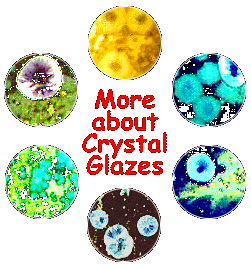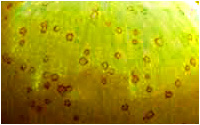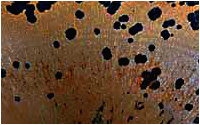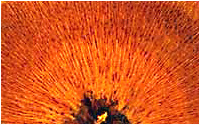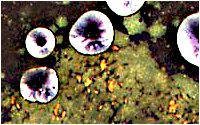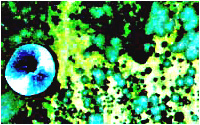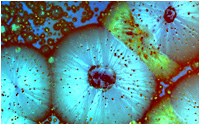| I think I have tested
about 2000 crystal glazes today. I use about 50 of them
often. When I have
invented a good base crystal glaze, I try to vary the
coloring oxides and carbonates. In that way I can get
many quite different glazes in an easy way. Sometimes the
coloring oxides affects the glaze in a bad manner and I
have to correct the base glaze. Be patient - donīt give
up!
For further tests I change
the Feldspars, try different amounts of Zinc, Dolomite,
Rutile, Whiting and Barium (maybe Strontium), change the
frits and substitute Lithium carbonate and common
Feldspars for Petalite or Spodumene.
For coloring I use: Ferric
oxide, Copper oxide and carbonate, Cobalt oxide and
carbonate, Nickel oxide and carbonate, Manganese
carbonate, Uranium dioxide,
and sometimes: Vanadium pentoxide, Molybdenum oxide,
Antimony oxide, Rutile and Ilmenite.
All, except a few, crystal
glazes fire at 1250-1280oC. You can
try Orton cone 7-9.
  For my
normal firing schedule (even crystal glazes!), look at my
"Firing Page". For my
normal firing schedule (even crystal glazes!), look at my
"Firing Page".
Best is porcelain and
white or light gray stoneware clays. Oxidation in an
electric kiln. Later I will add recipes for a silky mat
crystal glaze that fires in reduction.
I seldom try to get very
big crystals. I think the smaller (2-25mm) ones, often
very complex, together with running streaks suite my
taste better.
I do
not use a longer cooling and I do not use other, not so
runny, glazes near the bottom.
I spray all glazes in a normal way, and I have not to grind
away glaze from the bottom.
But I make a lot of glaze testing and control thickness
and temperature very careful. And if you are observant
you can see that there is not so little Alumina in the
crystal glazes!
Of course you can get very big crystals with my lithium
glazes, but then you must apply it and fire it in a
little different way (controlled cooling).

|
